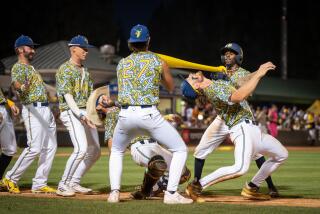Banana Republic Gains New Sovereignty by Going Upscale
- Share via
Justin Lowe considers himself among the growing number of “Banana Republicoholics.”
The 27-year-old New Yorker shops at the clothing and home furnishings chain at least once a month, recently adding a scarf and boxer shorts to his vast Banana Republic collection.
“The stuff is good quality, sophisticated, but not too daring,” Lowe said.
Lowe and other stylish, urban professionals have helped Banana Republic become one of the country’s hottest retailers. This last year was pivotal to the Gap Inc.-owned company, considered the more polished sister to the Gap and Old Navy chains, but a business that unlike its siblings has struggled in past years to come into its own.
Banana Republic introduced television ad campaigns for the first time in its 20-year history. It brought back a redesigned catalog after a nine-year hiatus that some believe raised the bar for mail-order design. Dozens of new stores opened across the country, and the San Francisco-based retailer added more luxurious merchandise to its mix.
“Banana Republic’s performance has improved quite a bit, especially in the past six months, and marketing has been a big factor,” said retail analyst Rick Snyder of Morgan Keegan & Co. in Memphis. “I recently walked into a Banana Republic and I was blown away by the presentation and merchandise. I think it finally got the right formula.”
Banana Republic’s prospects this Christmas appear particularly cheery. The 281-store chain invested heavily in suede and cashmere clothing, two fabrics that analysts say are flying off shelves this holiday shopping season.
Richard Baum, an analyst at Goldman Sachs, estimates Banana Republic will generate $1.2 billion in sales this year, up from $900 million in 1997. Same-store sales will rise 11% this year, Baum said.
During the third quarter, Banana Republic’s same-store sales rose roughly 15%, contributing to Gap Inc.’s overall 45% earnings gain.
As New York fashion consultant Harry Bernard puts it: “Banana Republic is going gangbusters.”
Even so, Bernard and others believe that Banana Republic has just begun to hit its stride because it targets a huge base of baby boomers and maturing Generation Xers.
However, with the current bombardment of television and print ads and slew of new store openings, the fashion firm runs the risk of oversaturating the brand, which could turn off fashion-conscious consumers, analysts said. The chain also is the most vulnerable in the Gap Inc. family to market downturns.
“The biggest risk Banana Republic runs is that if the economy turns south, high price points will be less appealing,” Snyder said.
Still, analysts aren’t calling for a slowdown any time soon.
Experimenting With Identity
Banana Republic has come a long way since its debut in 1978, as a mail-order clothing business with a safari motif. After Gap Inc. bought the company in 1983, it experimented with Banana Republic’s image and merchandise. It discontinued the catalog in 1989, and phased out the “out-of-Africa” theme in the late ‘80s, although it still sells such items as “Kenya convertible pants” and a “photojournalist’s vest.”
During its experimentation era, Banana Republic found itself with an identity problem. The company’s frequent make-overs confused customers, and the brand had no clear image.
But slowly, Banana Republic evolved into an upscale clothier, catering to men and women who want well-made clothes that are more timeless than faddish. It also added fashionable home accessories a couple of years ago.
The typical Banana Republic customer is between 25 and 49, lives in a metropolitan area and might also purchase clothing from J. Crew, DKNY, BCBG or Bloomingdale’s. About a third of Banana Republic’s customers have an annual household income of more than $100,000, while about 40% draw $50,000 to $100,000.
“We’re a brand for grown-ups,” said Amy Schoening, Banana Republic’s vice president of marketing. “We try to meet the needs of a modern lifestyle and offer a wardrobe that’s very versatile.”
Schoening said the company in recent years has targeted more affluent consumers by raising its styling and pricing. Store shelves are now stocked with cashmere sweaters, suede coats and Italian merino wool cardigans, with price tags running about $65 for a cashmere scarf, $395 for a lambskin jacket and $56 for a set of four martini glasses.
Refining its merchandise has aided in Banana Republic’s revival, but the retailer also has benefited from the master marketing of its parent company.
Like Gap’s khakis ad campaign, Banana Republic’s in-house suede and holiday television commercials have won raves for delivering strong, enticing images.
Banana Republic’s fall television campaign featured a diverse group of people swaying to “Feeling Good,” by jazz singer Nina Simone. The in-house holiday commercials offer a montage of tender moments, such as a young couple kissing on a city street. A Finley Quaye reggae song, “Your Love Gets Sweeter,” plays in the background.
“The models in Banana Republic ads are the people you hate, but always want to be like,” Snyder of Morgan Keegan said. “They’re very confident, cool and hip.”
The commercials have aired during such shows as “Ally McBeal,” “ER” and “Friends,” whose audiences include Banana Republic’s prime customer.
Banana Republic’s foray into television advertising has been a pricey investment. Last year, the company spent $4.7 million on advertising, almost exclusively in magazines, according to Competitive Media Reporting. This year, it more than tripled its budget to an estimated $16.5 million.
But after this past fall’s stellar performance, analysts and Banana Republic executives believe the high-profile campaigns paid off.
“We’ve had a better reaction from the television campaign than we expected,” Schoening said. “One of the reasons we wanted to go on television is because it allowed us to use sound and movements. Customers say we have a sensual brand, and the commercials affirmed our brand.”
Mail-Order Catalog Makes a Comeback
In fall this year, Banana Republic also brought back its catalog. The company would not comment about the cost of its mail-order business, but analysts said big bucks were spent.
Banana Republic opened a 90,000-square-foot distribution center in Ohio and hired 200 people to restart its mail-order business.
And instead of the typical glossy finish of most catalogs, the new Banana Republic catalog has a matte finish and is printed on high-quality paper. It also is bound like a book, instead of stapled in the center like most catalogs.
“We wanted to replicate the experience of shopping at our stores in our catalog,” Schoening said. “That’s why we used great paper and photography.”
The company inserted its catalog in major newspapers and in such magazines as GQ, Vanity Fair, Vogue and the New Yorker. Catalogs also are being distributed at prominent hotels and airports in New York, San Francisco and Chicago.
In addition, Banana Republic has been aggressively growing its chain. This year, it opened 40 new stores. Next year, 48 store openings are planned, said spokeswoman Cindy Capobianco.
Although some retailing experts caution that a too-rapid expansion could be harmful, Schoening isn’t worried.
“We still have a significant way to go to try to increase awareness of our brand,” she said. “Our strategy is to do it carefully, with the first push in major U.S. markets.
“The main thing we have to do is listen to our customer base and figure out what people are responding to. That’s how we’re going to successfully evolve.”
More to Read
Inside the business of entertainment
The Wide Shot brings you news, analysis and insights on everything from streaming wars to production — and what it all means for the future.
You may occasionally receive promotional content from the Los Angeles Times.










